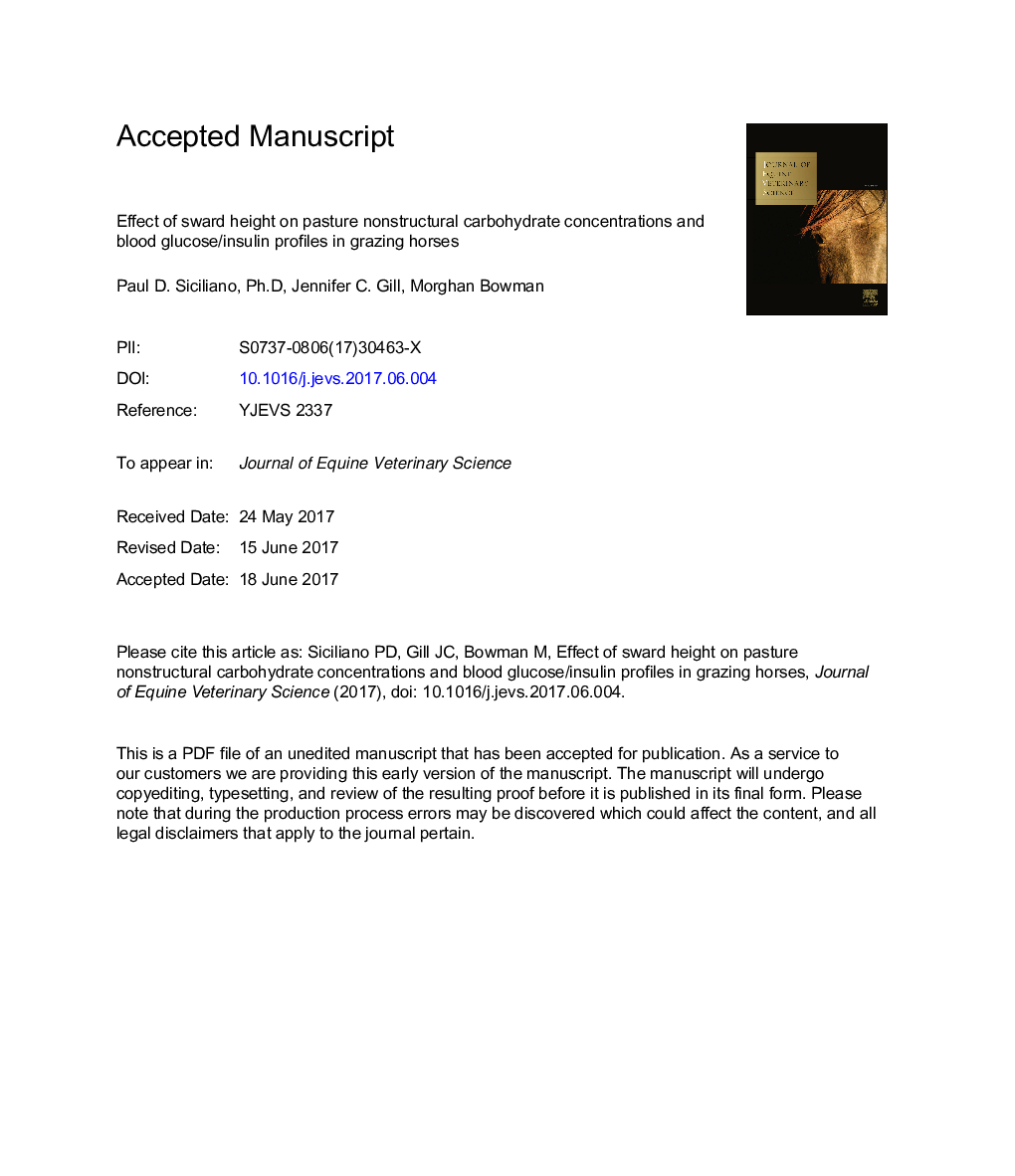| کد مقاله | کد نشریه | سال انتشار | مقاله انگلیسی | نسخه تمام متن |
|---|---|---|---|---|
| 5535666 | 1551543 | 2017 | 15 صفحه PDF | دانلود رایگان |
عنوان انگلیسی مقاله ISI
Effect of Sward Height on Pasture Nonstructural Carbohydrate Concentrations and Blood Glucose/Insulin Profiles in Grazing Horses
ترجمه فارسی عنوان
اثر ارتفاع سارق بر غلظت کربوهیدرات غیر غنی شده و غلظت گلوکز خون / پروتئین انسولین در اسب ها
دانلود مقاله + سفارش ترجمه
دانلود مقاله ISI انگلیسی
رایگان برای ایرانیان
کلمات کلیدی
اسب، کربوهیدرات غیر ساختاری مرغ، گاو نر. لامینیت،
موضوعات مرتبط
علوم زیستی و بیوفناوری
علوم کشاورزی و بیولوژیک
علوم دامی و جانورشناسی
چکیده انگلیسی
Six mature stock-type geldings with maintenance only requirements were used in a randomized cross-over design to determine the effect of sward height on pasture plant nonstructural carbohydrate (NSC) concentrations and blood glucose and insulin concentrations. Horses were randomly assigned to one of two tall fescue (Lolium arundinaceum Schreb cv Max-Q, Pennington Seed, Madison, GA) grazing cells (0.37Â ha) having two different sward heights for a period of 7Â days: (1) short (approximately 15Â cm; n = 3) or tall (between 30 and 40Â cm; n = 3). After the first 7-day period, treatment groups were reversed by moving horses to ungrazed cells having similar characteristics to those used in the first 7Â days, so that all horses receive all treatments resulting in six observations per treatment. Both short and tall grazing cells were mowed to a height of approximately 15Â cm 32Â days before the experiment starts. The short grazing cells were removed to approximately 15Â cm at 11Â days before the start of the first 7-day period and again 1Â day before the start of each 7-day period. All horses had access to pasture for 10Â h/d beginning at 8 AM and ending at 6 PM. Although not at pasture, all horses were individually housed in 3.7 Ã 12.2Â m partially covered pens containing automatic water troughs and a crushed stone surface. Herbage mass (kg DM/ha) was determined by use of a falling plate meter for each pasture to ensure that both groups of horses had adequate dry matter to provide grazing for at least 7Â days. On day 7 of each period, jugular venous blood samples were collected from each horse before being turned out to pasture, and then at 2, 4, 6, and 8Â hours after turn-out. Pasture samples were also collected from each grazing cell at the same time blood samples were taken. Serum and plasma from blood samples were harvested and analyzed for insulin and glucose concentrations, respectively. Pasture samples were analyzed for water soluble carbohydrate (WSC), ethanol soluble carbohydrate (ESC), and starch. The sum of WSC and starch were used as an estimate of NSC. Area under the curve (AUC) and peak concentration were calculated for both plasma glucose (PPG) and serum insulin (PSI) concentration and were analyzed using analysis of variance for randomized cross-over designs. Pasture WSC, ESC, starch, and NSC concentrations were analyzed using analysis of variance for randomized complete block design. A P value of < .05 was considered significant. Mean pasture plant NSC, WSC, and ESC concentrations were lower (P < .001) in short as compared with tall. Pasture plant starch concentration was not different between treatments. Mean pregrazing plasma glucose concentrations, PPG concentrations, and plasma glucose AUC were not affected by treatment. Mean pregrazing serum insulin concentrations were not affected by treatment. Mean PSI and insulin AUC were greater (P < .01) when horses grazed tall, as compared with short. In conclusion, decreasing the sward height by mowing pasture decreased NSC, WSC, and ESC concentrations and subsequently decreased the postprandial insulin response of horses grazing the pasture. These findings may be important in developing strategies aimed at preventing insulin resistance in grazing horses.
ناشر
Database: Elsevier - ScienceDirect (ساینس دایرکت)
Journal: Journal of Equine Veterinary Science - Volume 57, October 2017, Pages 29-34
Journal: Journal of Equine Veterinary Science - Volume 57, October 2017, Pages 29-34
نویسندگان
Paul D. Siciliano, Jennifer C. Gill, Morghan A. Bowman,
